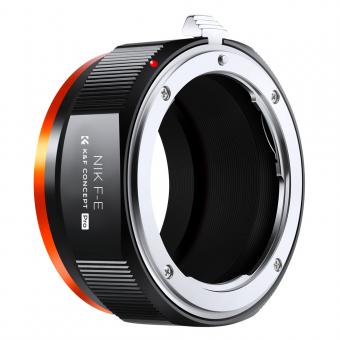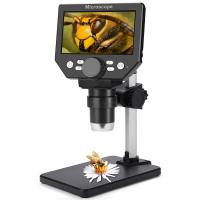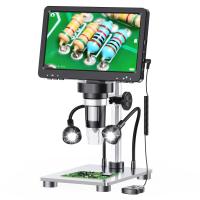When Were Microscopes First Used ?
Microscopes were first used in the late 16th century. The exact date is uncertain, but it is believed that the Dutch spectacle maker Zacharias Janssen and his father Hans Janssen invented the first compound microscope around the year 1590. This early microscope consisted of a convex objective lens and a concave eyepiece lens, which allowed for magnification of small objects. The invention of the microscope revolutionized the field of biology and enabled scientists to observe and study microscopic organisms and structures in detail. Over the centuries, microscopes have undergone significant advancements in design and technology, leading to the development of various types of microscopes with different capabilities and applications.
1、 Early Microscopic Observations in Ancient Times
Microscopes, as we know them today, were not used in ancient times. However, early forms of microscopic observations can be traced back to ancient civilizations. The ancient Egyptians, for instance, used simple lenses made from polished crystals to magnify small objects. These lenses were not true microscopes but allowed for some level of magnification.
The first recorded use of a true microscope dates back to the 17th century. In 1665, the English scientist Robert Hooke published his book "Micrographia," which detailed his observations using a compound microscope. Hooke's microscope consisted of a lens system that allowed for higher magnification and better resolution than previous devices.
Hooke's work paved the way for further advancements in microscopy. In the following years, other scientists, such as Antonie van Leeuwenhoek, made significant contributions to the field. Leeuwenhoek, a Dutch scientist, improved the design of the microscope and achieved even higher magnification. He was the first to observe and describe microorganisms, such as bacteria and protozoa, using his microscopes.
Since then, microscopy has undergone tremendous advancements. Modern microscopes utilize complex optical systems, including multiple lenses and advanced illumination techniques, to achieve high-resolution imaging. Additionally, the development of electron microscopy in the 20th century allowed for even greater magnification and the visualization of structures at the atomic level.
It is important to note that the concept of microscopy and the use of lenses to magnify objects have been present in various forms throughout history. However, the true microscope, as we understand it today, was first used in the 17th century and has since evolved into a powerful tool for scientific research and discovery.
2、 Development of Compound Microscopes in the 17th Century
The use of microscopes has revolutionized our understanding of the microscopic world. The first microscopes, known as compound microscopes, were developed in the 17th century. These early microscopes consisted of two or more lenses that magnified the image of the specimen being observed.
The credit for the invention of the compound microscope is often given to Dutch scientist Antonie van Leeuwenhoek. In the late 17th century, Leeuwenhoek crafted small, high-quality lenses and used them to observe a wide range of specimens, including bacteria, blood cells, and spermatozoa. His observations opened up a whole new world of understanding and laid the foundation for the field of microbiology.
However, it is important to note that Leeuwenhoek was not the only scientist working on microscope development during this time. Robert Hooke, an English scientist, also made significant contributions to the field. In 1665, Hooke published his book "Micrographia," which included detailed illustrations of various objects observed under a microscope. His work further popularized the use of microscopes and inspired many other scientists to explore the microscopic world.
Since the 17th century, microscopes have undergone significant advancements. The lenses have become more refined, allowing for higher magnification and better resolution. The introduction of electric lighting and the development of more sophisticated imaging techniques, such as electron microscopy, have further enhanced our ability to observe and understand the microscopic world.
In recent years, there have been further advancements in microscopy, such as the development of super-resolution microscopy techniques. These techniques allow scientists to observe structures at the nanoscale, providing even more detailed information about biological processes.
In conclusion, the development of compound microscopes in the 17th century marked a significant milestone in scientific discovery. Since then, microscopes have continued to evolve, enabling scientists to explore the intricate details of the microscopic world and uncovering new insights into the workings of life.
3、 Advancements in Microscopy Techniques during the 18th Century
Microscopes were first used in the late 16th century, with the credit often given to Dutch spectacle makers Hans and Zacharias Janssen. However, it was not until the 18th century that significant advancements were made in microscopy techniques.
During the 18th century, several notable developments took place that revolutionized the field of microscopy. One of the key advancements was the improvement of lens quality, which allowed for higher magnification and better resolution. This was achieved through the use of achromatic lenses, which reduced chromatic aberration and improved image clarity.
Another significant development was the introduction of the compound microscope. This type of microscope utilized multiple lenses to magnify the specimen, providing a more detailed view. The compound microscope became widely used in scientific research and played a crucial role in the discovery of many microscopic organisms.
Additionally, the 18th century saw the refinement of staining techniques, which allowed for better visualization of cells and tissues. Scientists began using various dyes and stains to highlight specific structures within the specimens, enabling more detailed observations.
Furthermore, the introduction of polarized light microscopy in the 18th century opened up new possibilities for studying crystalline materials and minerals. This technique involved the use of polarized light to examine the optical properties of specimens, providing valuable insights into their composition and structure.
In recent years, there have been further advancements in microscopy techniques, driven by technological innovations. These include the development of electron microscopy, which uses a beam of electrons instead of light to magnify specimens, allowing for even higher resolution imaging. Additionally, techniques such as confocal microscopy and super-resolution microscopy have pushed the boundaries of what can be observed at the nanoscale.
In conclusion, while microscopes were first used in the late 16th century, it was during the 18th century that significant advancements in microscopy techniques occurred. These developments laid the foundation for further progress in the field, leading to the sophisticated microscopy techniques we have today.
4、 Introduction of Electron Microscopes in the 20th Century
Microscopes have played a crucial role in advancing our understanding of the microscopic world. The first microscopes, known as optical microscopes, were developed in the late 16th century. These early microscopes used visible light to magnify objects, allowing scientists to observe and study specimens at a much smaller scale.
However, it was not until the 20th century that the introduction of electron microscopes revolutionized the field of microscopy. Electron microscopes use a beam of electrons instead of light to magnify objects, providing much higher resolution and greater detail. This breakthrough technology allowed scientists to observe structures and processes at the atomic and molecular level.
The first practical electron microscope was developed in 1931 by Ernst Ruska and Max Knoll. This instrument used a magnetic field to focus the electron beam and produced images with a resolution of about 50 nanometers. Over the years, electron microscopes continued to improve in resolution and functionality.
In recent years, advancements in electron microscopy have further expanded its capabilities. For example, the development of scanning electron microscopes (SEM) allowed scientists to obtain three-dimensional images of specimens by scanning the surface with a focused electron beam. Transmission electron microscopes (TEM) have also been enhanced, enabling researchers to study materials at an even higher resolution.
Today, electron microscopes are widely used in various scientific fields, including biology, materials science, and nanotechnology. They have become indispensable tools for studying the structure and properties of materials, investigating cellular and molecular processes, and advancing our knowledge of the natural world.
In conclusion, while optical microscopes were first used in the late 16th century, it was the introduction of electron microscopes in the 20th century that truly revolutionized the field of microscopy. These powerful instruments have allowed scientists to explore the microscopic world with unprecedented detail and have greatly contributed to our understanding of the natural world.






































